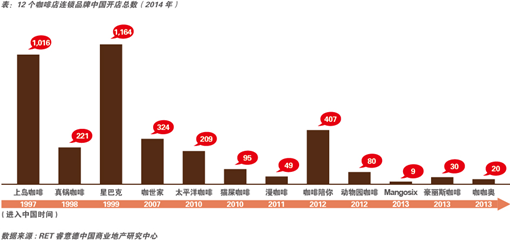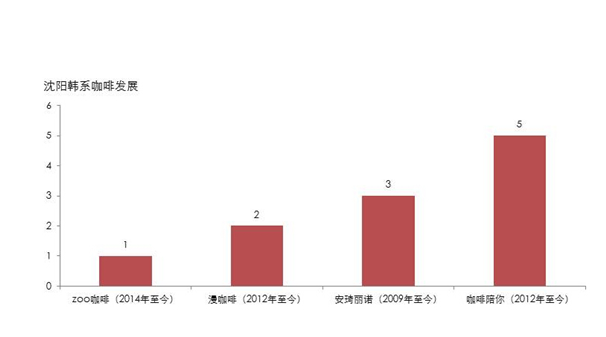Research report on the Development trend of Korean Coffee shops in China
In the traditional impression, Starbucks, a European and American coffee shop brand, has been a "cafe landscape" in major cities for a long time, but in recent years, similar to popular film and television dramas, fashion clothing and other fields, there has also been a "Korean wave" in the coffee shop field. On August 18, RET Ruiyide China Commercial Real Estate Research Center released the first Research Report on the Development Trend of Korean Coffee Shop in China. The report tracks the development trajectory of 12 representative coffee shop chain brands in China in the past 17 years, and makes a comprehensive analysis of the expansion of Korean coffee shops. Data show that Korean coffee shops have expanded rapidly, opening nearly 600 stores in the last two years alone.
Shi Jin, chief analyst of RET Ruiyide China Business Research Center, pointed out,"At present, Korean coffee shop chain brands are developing rapidly in China. What is particularly noteworthy is its layout in the core business circle of second-tier and third-tier cities, as well as flexible cooperation mode, so that the overall market pattern is changing."
Korean coffee shops opened momentum from behind
In recent years, Korean coffee shop brands represented by coffee accompany you and diffuse coffee are gradually covering every corner of many cities in China. The statistics also reflect the growing "Korean Wave" in the coffee shop sector. RET Ruiyide China Commercial Real Estate Research Center statistics show: Starbucks in Europe and the United States coffee shop brand expansion is the fastest, currently there are 1,164 in China, an average of 77 stores per year; Taiwan coffee shop brand leader is Shangdao coffee, currently there are 1,016, with an average annual expansion rate of 59; Among the Korean coffee shop brands, coffee accompanies you most prominently. In just two years after entering China, 407 coffee shops have been opened, and they are still expanding at a high speed. Their expansion momentum even exceeds Starbucks.

Rich product mix to achieve differentiated competition
In terms of product richness, the average number of products of Korean coffee shop brands is 76, almost double that of 41 European and American coffee shop brands. In addition to coffee, tea, smoothies, cakes, sandwiches and other common coffee shop brands, Korean coffee shop brands have also added product lines such as smoothies, soda, ice cream, cereal lattes, muffins and toast. At the same time, unlike European and American coffee shop brands, Korean coffee shop brands also focus on non-coffee drinks in their product structure, accounting for 49% of all products, facilitating differentiated competition.
More flexible cooperation mechanisms
In terms of business model, different from the high proportion of direct sales of European and American coffee shop brands and the multiple agency mechanism of Taiwanese coffee shop brands, RET Ruiyide China Commercial Real Estate Research Center found in the survey that Korean coffee shop brands weighed the proportion of different business modes well in the process of expansion, and the proportion of direct sales and franchising was 19% respectively. 60% and 21%? It is the proportion of cooperative operation, that is, the management party and franchisees jointly participate in the operation. Both parties have part of the equity. Take coffee accompany you as an example. The minimum investment for joining is only 500,000 yuan. In addition to the cooperative store with 49% equity, coffee accompany you also cooperates with China Merchants Bank to provide franchisees with credit as financial products to attract franchisees to the maximum extent. These business models balance the relationship between equity allocation, post-management and quality control of coffee shops. In the expansion strategy, Korean coffee brand avoided the direct conflict with European and American coffee shops and Taiwanese coffee shops.
Site selection strategy adapted to local conditions
Because Korean coffee shop brands enter the first-tier cities late, urban resources are seized, and the rental area of single stores is larger, so as many as 69% of stores in first-tier cities are located in suburbs. On the other hand, community commerce in first-tier cities has developed relatively mature, and the low rental cost and stable regional flow in suburbs provide a foundation for Korean coffee shop brands to enter the suburbs.
With the rapid development of economy and consumption in second-tier and third-tier cities, Korean coffee shop brands have seen the market potential of leisure cafes in these cities. Therefore, most brands choose to enter urban areas more, and their urban location accounts for 87%. In the urban area where the traffic is most concentrated, excellent store resources and open display surface help Korean coffee shop brands known for their environmental layout to attract strong traffic with optimal image display, rapidly expand their popularity, and then contribute to their rapid expansion.
The latest data shows that since the first Korean coffee shop Anqi Linuo entered Shenyang in 2009, Shenyang has 11 Korean coffee shops, among which coffee accompanies you to open the most vigorous momentum. After entering Shenyang in 2012, there have been 5 shops, which is the Korean coffee shop with the most stores in Shenyang.

Liang Weihua, director of RET Ruiyide and general manager of Shenyang Company, said that Shenyang Korean coffee shops are more popular in the area where young people gather; Korean pop elements are added to the decoration style, which is more fashionable; in addition, Korean drama, Korean current and other related factors also make Korean coffee shops popular among Shenyang young people.
Brand implantation diversified promotion
In order to shake the traditional position of Starbucks and Shangdao Coffee in China, Korean coffee shop brands have also invested a lot in marketing means, including brand implantation by virtue of the high ratings of Korean idol dramas in China, and hiring popular stars as spokesmen to maximize star effect. At the same time, the Korean coffee shop brand also injected O2O, trying to bring more functional elements to the coffee shop. It is reported that coffee company you have planned to cooperate with Shunfeng, through mobile phone positioning after ordering, realize take-out service "coffee house delivery". The development of this new field not only caters to the consumption habits of young people O2O to enhance customer stickiness, but also covers the areas where physical stores have not yet set foot with the help of logistics network.
Shi Jin pointed out that "at present, China's coffee shop market is still broad, with flexible cooperation methods and diversified marketing promotion advantages, especially Korean dramas and stars in China's vast urban audience, Korean coffee shops in the second and third tier cities penetration will be more in-depth." Including new brands such as Mangosix, although the number of stores is not large at present, it is expected that 2015-2016 will usher in a new round of store opening peak."
Important Notice :
前街咖啡 FrontStreet Coffee has moved to new addredd:
FrontStreet Coffee Address: 315,Donghua East Road,GuangZhou
Tel:020 38364473
- Prev

The Truth of Fair Trade in a Cup of Coffee
Fair Trade is a social movement launched by developed countries to provide fairer terms of trade through a number of international aid organizations to protect the rights and interests of workers and producers in poor countries. Some economists believe that "fair trade" is essentially a form of subsidy, which hinders economic development and cannot eradicate the problem of poverty.
- Next

More than half of the coffee shops in China do not make money from coffee.
A few days ago, a "profiteering door" news that the price of Starbucks coffee in the Chinese market is fully higher than that in the United States, causing widespread debate in the society. There are doubts that Starbucks' differential pricing is contrary to the principle of fairness, but there is also a view that calculating only the cost of raw materials while ignoring other operating costs obviously lacks economic common sense, coffee belongs to a non-monopoly industry, and its pricing power should be vested in the market and
Related
- What ratio of water temperature and ground does the smart cup method use to press coffee? The difference between brewed coffee and filtered coffee?
- What is the standard process for the purpose of coffee cup testing? What is the difference between hand-brewed coffee and cup testing?
- How to use hand-brewed coffee paragon small golden balls? How does cold coffee lock in the aroma of coffee?
- Is American coffee black? What is the difference between American coffee and drip coffee?
- Unexpected! Well-known tea beverage brand Lele Tea will withdraw from the Zhengzhou market!
- Starbucks enters the fashion and beauty industry?! Netizen: Give me an ice American eye cream
- Why can American refills for free? The difference between Americano and American drip pot coffee
- Being chased out of the rain in front of Starbucks?! Store: Sheltering from rain under umbrellas poses a safety hazard
- The white moonlight has changed?! Lucky launches "Big Winter Pear American"
- Hand-brewed coffee three-stage method, high-sweet and universal brewing method to share! What does the high sweet water level of hand-brewed coffee mean?

